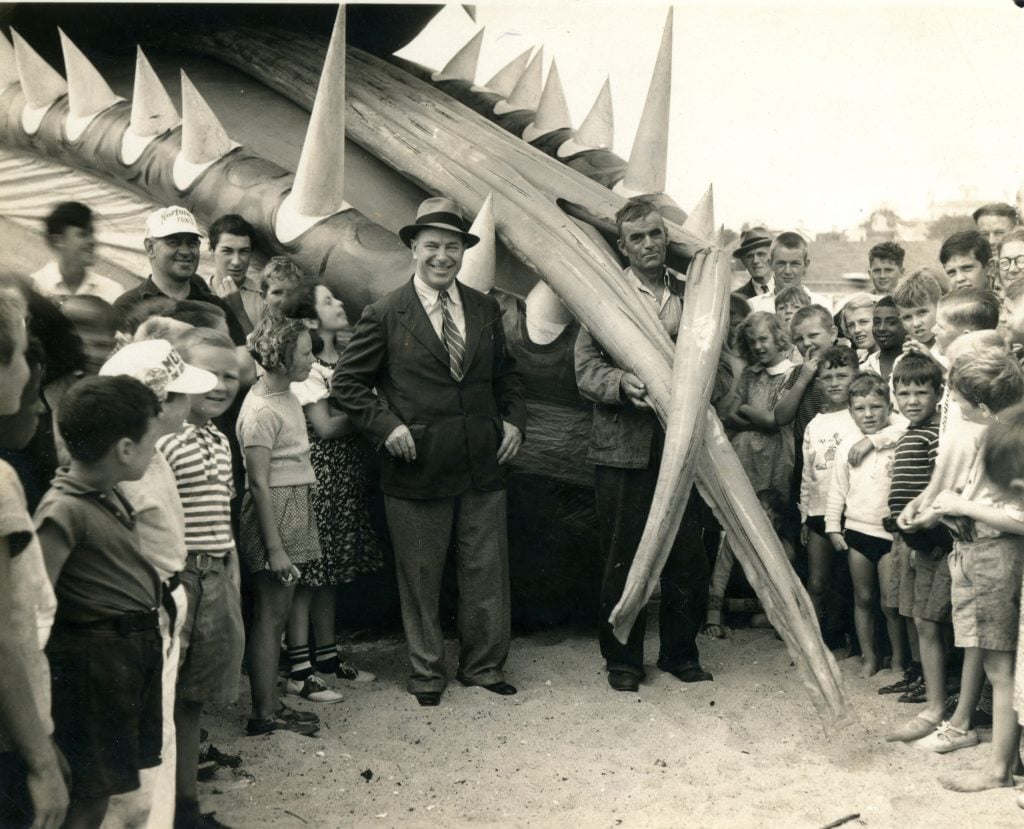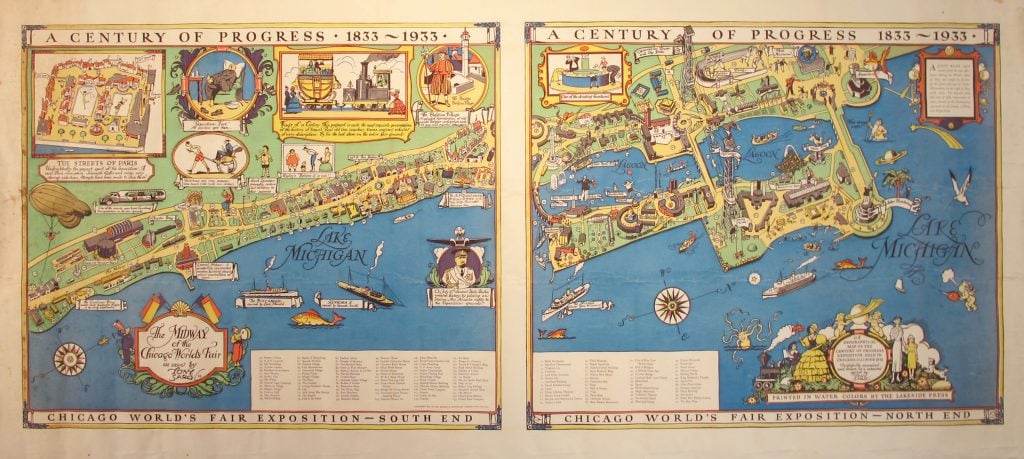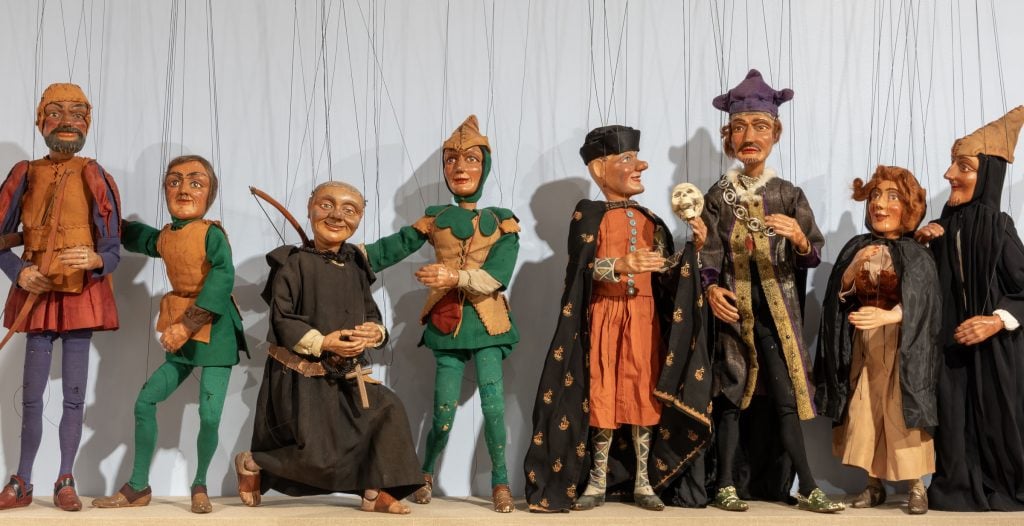Art & Exhibitions
A Legendary Puppeteer Who Pulled Off a Sea Monster Hoax Gets an Islandwide Tribute in Nantucket
Meet Tony Sarg, the man behind the tradition of balloons at the Macy's Thanksgiving Day Parade.

Meet Tony Sarg, the man behind the tradition of balloons at the Macy's Thanksgiving Day Parade.

Richard Whiddington

One August day in 1937, the national media descended on Nantucket, the tiny island off Cape Cod, Massachusetts. For weeks, newspapers had relayed sightings by fishermen of a giant sea monster, reports that were soon backed up by photographs of reptilian footprints striding across Madaket Beach.
Then, one morning, the monster appeared, drifting on the waves and whipping the town into a frenzy. The thing that washed ashore was monstrous, but hardly terrifying: a 125-foot green balloon with gleeful eyes and cutesy horns. Its name was Morton, as Tony Sarg, the prankster responsible, informed them.
Eighty-seven years on, Nantucket has staged something of a reenactment, floating aloft a 75-foot recreation of the beast for locals to pet and pose with.
If you’ve never heard of him, that’s precisely the reason for Summer of Sarg, a season of programming seeking to revive the legacy of a creative jack-of-all-trades who joined the island’s burgeoning artist community each summer beginning in 1920.
To do so, the Nantucket Historical Association has spread Sarg’s artwork and artifacts across the island’s various cultural centers. The breadth and diversity of his output is startling.
At Map House, Sarg reflects on a century of civilizational progress for the Chicago World’s Fair in 1933, a scene of zeppelins, rollercoasters, telescopes, and, yes, cartoonish sea monsters. At the Whitney Research Library, Sarg the storyteller plays out in children’s books and humorous sketches of the modern city. At the Whaling Museum’s “Tony Sarg: Genius at Play,” there’s Sarg the puppet master, balloon wizard, and serial entrepreneur.

Tony Sarg, Geographical Map of the Century of Progress Exposition Held in Chicago, Illinois (1933). Photo: George F. Korn.
Sarg’s star rose in the 1920s through the success of his marionette company, which revolutionized the art form and toured America to great fanfare and profit. Growing up on his father’s Guatemalan sugar and coffee plantation, Sarg created a pulley system to feed chickens, and this mechanical knack would stay with him—case in point, the 24-string airplane-shaped controller he invented that gave his puppets ultra-realistic movements.
Partly on the back of connections forged through his successful window display enterprise, Tony Sarg Studios, he was invited to blow up his marionettes and send them skyward for Macy’s Thanksgiving Day Parade in 1927, beginning a tradition that continues to this day. Black-and-white photographs tell the story. In one, a sea of hats throng around Macy’s Herald Square windows. In another, Sarg’s assistants paint an aloof expression onto a giant balloon head.

Tony Sarg and his assistants painting a parade balloon. Photo: Fotograms News/Nantucket Historical Association.
Sarg’s success may seem a typical American tale of entrepreneurial hustle, but his arrival in the country was circuitous and by necessity, rather than by choice. Sent to a German military academy by his father, Sarg rose to lieutenant in the horse artillery before resigning and moving to London in 1905 to pursue a career as an illustrator. He thrived, but anti-German sentiment amid the tumult of World War I forced him across the Atlantic in 1915.
In America, Sarg found a country open to a charismatic man with the gift of self-promotion. His relationship to puppetry neatly captures this spirit. Back in England, puppeteering was often a family affair, an enterprise that closely guarded its secrets. One such act was Thomas Holden and his Imperial Marionettes, and when Sarg went backstage, inquiring after its techniques, he was rebuffed. As Sarg later told it, his response was to attend 50 performances with a sketchbook and binoculars at hand. Once successful in America, Sarg displayed the opposite impulse: he opened a puppetry school and published The Tony Sarg Marionette Book.

The cast of Sarg’s Robin Hood puppets. Photo: courtesy of the Nantucket Historical Association © 2024 Bill Hoenk Photography.
This is a testament to both Sarg’s generosity and his entrepreneurial sense. “He was able to leverage success in one area and then launch a whole new endeavor,” said Deborah Sorensen, the exhibition’s curator, who noted his ability to turn illustration into animation, or puppet into balloon. “He’s Walt Disney before Walt Disney. He cultivated a brand by putting his name as a banner above toys, books, the animated series he produced.”
In “Genius at Play,” we meet the full package, from his Robin Hood marionettes to his experiments in animation to the novelty powder jars produced by the Tony Sarg Shop, which had outlets in Manhattan, Pennsylvania, and Nantucket.
Which begs the question: why isn’t Sarg a household name today? Sorensen pointed to his premature death at 61, before the popularization of film and television, mediums he surely would have explored.
In another sense, Sarg’s shadow still lingers over contemporary culture. Sarg mentored Bill Baird, famous for The Sound of Music’s puppetry scene, who in turn mentored Jim Henson, creator of the Muppets.
“Tony Sarg: Genius at Play” is on view at the Whaling Museum, 13 Broad St, Nantucket, Massachusetts, through December 30.